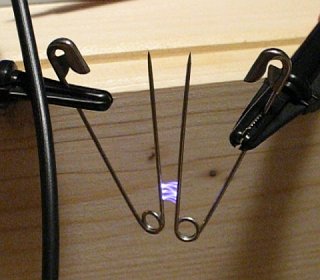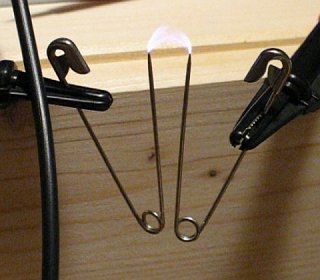


A very simple Jacob's ladder
When you do high voltage experiments, then this is an experiment, which simply should not be skipped. With very simple materials (besides a high voltage power supply, capable of providing reasonable current) you already can make a miniature Jacob's ladder. This phenomenon is very spectacular, both watching it, but also hearing it, provided a 50 Hz or 60 Hz AC power supply is used.
![]()
Required equipment:
- Two large safety pins.
- Wires and crocodile clamps.
- High voltage power supply, capable of delivering at least 5 kV AC at 10 mA. A higher output voltage is preferable. In this actual experiment, a 8 kV / 10 mA / 50 Hz AC power supply was used. A simple neon sign transformer is perfectly suitable for this experiment as well.
Safety:
-
 The voltages,
combined with the fairly high currents, used in this experiment, are very
dangerous. If such a current is going through your body, then you may be
killed.
The voltages,
combined with the fairly high currents, used in this experiment, are very
dangerous. If such a current is going through your body, then you may be
killed. -
 This experiment
must be done with a power supply, which has current limiting. As soon as
current increases, the voltage must drop. A neon sign transformer is
perfectly suitable for this. If a power supply is used with stiff voltage
regulation (e.g. a series connection of microwave oven transformer), then
the current will grow without limit, resulting in destruction of the power
supply and the risk of fire. Use a ballast resistor is such a power supply
is used.
This experiment
must be done with a power supply, which has current limiting. As soon as
current increases, the voltage must drop. A neon sign transformer is
perfectly suitable for this. If a power supply is used with stiff voltage
regulation (e.g. a series connection of microwave oven transformer), then
the current will grow without limit, resulting in destruction of the power
supply and the risk of fire. Use a ballast resistor is such a power supply
is used.
![]()
Setup of the experiment
The setup for this experiment is simple. The safety pins must be opened and positioned relative to each other, such that the round side of them is closest to each other and at the bottom. The following picture shows how they have to be connected.

The narrowest gap between the two safety pins is approximately 4 mm. If the distance is too small, then the spark does not move upwards, it sticks at the bottom. If the distance is too large, then no spark is formed. With your actual power supply, some tuning and testing may be necessary, but making a Jacob's ladder with two safety pins should not be too difficult and a few minutes of trial and error will definitely give good results.
![]()
Jacob's ladder in action
When the power is switched on, then an arc is created at the bottom, and this arc moves upwards. Sometimes it moves upwards beyond the end of the two needles of the safety pins. Sometimes, it stops earlier, and a new arc is created at the bottom prematurely. The following pictures show a few pictures from 3 cycles of the arc moving upwards. Click on one of the pictures for a full series of pictures, at full resolution. The full series of pictures opens up in a new window.
Each row shows one cycle. The second cycle is not complete, before the arc reaches the top of the needles, a new arc is formed already again at the bottom.
There also is an animation, showing a small video of the Jacob's ladder. Click here for the video. The size of the animation file is approximately 2 MByte. The Jacob's ladder also was filmed in total darkness. This animation can be viewed by clicking here. The size of this file is approximately 500 kByte.
![]()
Discussion of results
It is fairly easy to explain the operation of a Jacob's ladder.
- Initially, when there is no arc at all, the arc is formed at the place, where the electrodes are closest to each other. The actual voltage across the electrodes determines how large a gap can be bridged.
- The arc is very hot and the air in and around the arc heats up. This causes expansion of the air and moving upwards of the air. The ionized path, through which is arc-current is flowing, also is moving upwards, together with the hot air. This causes the arc to move upwards. Although the distance, bridged by the arc increases, it still chooses the path of the existing arc. That path is ionized and a much lower voltage is needed for bridging that path, than any non-ionized path.
- The path moves upwards further. At a certain point, the current is not sufficient to keep the arc sufficiently conducting. This either happens when the arc become too long, or at the tips of the needles, where the arc bends, due to the rising hot air.
- Finally, a point is reached, where the arc cannot be maintained anymore. As soon as this happens, the current stops, and the voltage across the electrodes increases again. A new arc is formed at the place, where the electrodes are closest to each other, and a new cycle starts.











